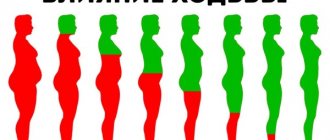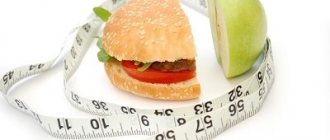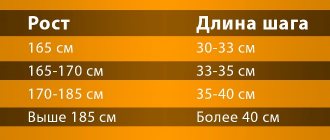The 10,000 steps myth is very common in the fitness industry. The task is as simple as it is banal. You should take at least 10,000 steps per day to maintain the required level of activity.
Thomas Hirai, medical director of the Center for Obesity and Metabolic Diseases at O'Connor Hospital in San Jose, California, explains that the idea for the 10,000 mark dates back to 1965. At that time, a Japanese company developed a pedometer called “Manpo-kei,” which can be translated as “10,000 step counter.”
“The overall goal of 10,000 steps was set because the number was clear and easy to remember. It was also higher than the average number of steps most people took per day,” the doctor said.
Losing weight requires a calorie deficit
If you want to lose weight, your daily step count is just one of several aspects. Losing weight is mostly about creating a calorie deficit. This means that you must burn more calories than you consume. At the same time, energy can be spent in a variety of ways: through various sports, as well as through walking. 10,000 steps a day can help you reach your ideal weight. But be careful - this is not a guarantee of weight loss.
What determines how many calories are burned when walking?
The movement is accompanied by muscle tension, joints work, blood circulation and oxygen supply to the brain increases, human thinking is activated and improved.
You can determine the number of calories burned taking into account several factors:
- amount of time spent walking;
- mileage of distance covered;
- body weight, height, leg length;
- the age of the pedestrian is taken into account;
- metabolic features;
- health status;
- type and methods of walking;
- time of day and area conditions.
How many calories do you burn in 10,000 steps?
Most people burn between 30 and 40 calories for every 1,000 steps they take. 10,000 steps will burn between 300 and 400 calories. The exact quantity is determined individually. Not every body burns the same amount of calories with the same movements. Consumption is influenced by internal (weight, height, age) and external conditions (slope or pace).
Russians were named 4 habits that can increase life expectancy
Men's hair requires special care: the basics of hygiene and beauty
A climatologist told how the current winter was abnormally cold
To get a personalized estimate of calorie intake, Hirai recommends a measurement method called metabolic equivalent (MET). It is used to compare human energy consumption in different activities. Walking briskly at about five kilometers per hour equals approximately 3.5 METs. If you're running uphill, the number can go up to six. To calculate calorie burn with MET you can use the following equation:
0.0175 x MET x Weight (in kilograms) = energy expenditure (in calories per minute)
Example: A 68-kilogram person walking on level ground at just under five kilometers per hour, reaching 3.5 MET, will burn just under four calories per minute. At a constant speed, it would take a person about 100 minutes to walk 10,000 steps (about eight kilometers in total). He will spend about 400 calories.
What determines the number of calories burned in ten thousand steps?
People, covering the same distance, spend different amounts of energy. Obese people lose more kcal when moving than normosthenics. The same applies to tall, long-legged walkers.
In addition to body weight, there are other factors that influence the amount of energy expended:
- Times of Day;
- terrain;
- distance traveled;
- walking pace;
- age, leg length;
- physical state;
- duration of classes.
If it’s hot outside, you walk uphill or with additional weights, the load increases, and along with it, energy consumption increases. Changes in pace also contribute to energy losses. When rebuilding, the body spends calories.
When moving at an average pace, 200 kcal/hour is lost, a slow walk burns 100. Race walking eliminates 300–400. Walking at a fast pace is recommended for young and older people who are watching their figure and do not have health problems. In the presence of chronic diseases, physical activity is reduced. In this case, leisurely walks in the fresh air are recommended. They will burn less energy, but will not cause harm to health. To lose weight, physical activity is combined with diet.
Systematic 10-15 minute walks normalize blood pressure and prevent hypertension. But with such activity, you shouldn’t count on burning a lot of calories.
Useful video on the topic:
Calories consumed or burned can be overestimated or underestimated
Most people today use apps or smartwatches to calculate their steps and calories burned. However, for a more accurate measurement, it would be useful to compare the values of the apps or smartwatch you are using with the calculated result using the formula above. “It is important to note that you should not rely solely on technical numbers. Calories consumed or burned can be overestimated or underestimated, explains Hirai. “However, these calculations are useful because they help maintain discipline.”
According to the expert, 10,000 steps is a good daily goal. But he also emphasizes that the key to maintaining a goal weight and a healthy lifestyle is regular exercise.
Exercising just 11 minutes a day in the evening can ensure longevity
The 11-year-old daughter of Olesya Fattakhova is growing up as a beauty. Just like mom (new photos)
No one needs: the fate of Jewish women scientists who fled from the Nazis to the USA
Calculate calorie consumption based on heart rate
In a state of rest while lying down, a person’s pulse is minimal and is called the resting pulse. When performing physical work, to meet the body's increased need for oxygen, the heart begins to beat faster, and the increase in heart rate is, to a first approximation, proportional to the power of the work performed (at the same time, at low loads, the heart rate is restrained by an increase in the volume of blood ejected by the heart into the aorta per contraction, and only then, when the stroke volume reaches its limit, does the load increase only due to increased heart rate).
You can calculate energy consumption when walking using the formula:
E = 0.002 x M x T x (P - PP)
where E is energy expenditure in kcal, M is body weight in kg, T is walking time in minutes, PP is resting pulse, and P is pulse during movement in beats per minute. The interesting thing about this formula is that it does not include the distance traveled, the speed, or the steepness of the climb - all this is taken into account by the heart rate.
The pulse rate can be measured by manual counting or with an electronic heart rate monitor, several times along the way, and take the average.
Example: A person weighing 70 kg walked a certain distance in 15 minutes, with a pulse of 90 beats/min, a resting pulse of 65 beats/min. Energy consumption is equal to 0.002 x 70 x 15 x (90 – 65) = 52 (kcal).
Such a calculation is also approximate, since the loss of calories when walking depends on the degree of training of a person (in trained people, compared to less trained people, performing the same work requires a lower heart rate), and the heart rate monitor is not able to evaluate it, and some information is lost.
There are also online calculators that allow you to calculate how many calories are burned when walking in an hour or other time. These walking calorie calculators usually require you to enter your weight, walking time, and distance traveled, and can be based on different algorithms since there is no single method for calculating how many calories you burn while walking for the reasons described above.
Can 10,000 steps a day help you reach your ideal weight?
Most people need a deficit of about 500 calories per day to lose about a pound per week. According to Hirai, people who want to lose weight or maintain their weight should exercise at least 150 to 200 minutes a week. 10,000 steps a day can help achieve this goal.
Other factors are also important in weight loss. Thomas Hirai emphasizes the importance of healthy eating. “Losing weight through exercise is much more effective when combined with diet,” he says.
How many calories are burned on average in 10,000 steps?
According to the results of laboratory studies, when walking this distance, a person spends approximately 450-500 kcal. This is almost 20% of all energy consumed per day. More accurate numbers can be obtained using a special formula:
RE = V/1590 x KSh,
where RE is energy consumption, kcal;
B is the weight of a person, kg;
KS - the number of movements made.
In terms of energy expenditure, walking 7 km is comparable to the following types of physical activity:
- cycling - 15-24 minutes;
- swimming - 60 minutes;
- race walking - 1.5 hours;
- fitness classes - 40-50 minutes;
- boxing - 40-50 minutes;
- climbing stairs - 40 minutes;
- house cleaning - 2 hours.
Is 10,000 steps a day a safe method of exercise?
Walking is considered the safest activity. However, if you haven't exercised for a long time, the goal of 10,000 steps a day may be too difficult to achieve. In some cases, you may be injured. “It's helpful to increase your number of steps per day and stay as active as possible. But at the same time, it is equally important to avoid injury if you want to lose weight in a healthy way in the long term,” says the expert.
Severely obese people, the elderly, and those with chronic illnesses should be especially careful. Hirai recommends gradually increasing your step count and taking 1,000 more steps per day each week until you reach your individual goal. Over time, walking can be replaced by a higher-energy activity, such as jogging or swimming, to burn more calories, Hirai says.
How to measure average walking speed?
According to statistics, a person walks 4000 steps per day; when walking in a ten-minute period of time, you can take 1000 steps.
Human movement takes into account the dynamics and pace of movement:
- Walking in the form of a walk - rest and movement in a park or square, the pace is slow, the average speed of a walking person is 3-4 km/h. When moving slowly, a person walks 70 steps per minute. A walking pace cannot be called healthy; there is no physical activity. For older people, a slow walk can only be beneficial.
- Walking is for health purposes - the movement is accelerated up to 120 steps per minute, you can walk 7 km/h. This option affects the general well-being of the body, the arterial system, and the body feels cheerful.
- Race walking is a method of movement designed for people who maintain physical health and a slim figure. The average speed reaches 16 km/h, the pulse accelerates to 180 beats per minute.
It is much more difficult to spend time standing; while walking, the stability of the body increases.
Activity is important for health
The recommendation to take 10,000 steps a day is a marketing slogan, not a scientific fact. However, scientific results have been able to show that more exercise, which can be measured by, among other things, the number of steps, is important for human health.
In general, however, according to Thomas Hirai, an active as well as healthy lifestyle is the best way to achieve permanent weight loss. Challenging yourself to get 10,000 steps a day can be part of this. But it doesn't have to be walking. Any exercise that you do consistently is a good choice.
“There’s really no magic number that will get you to your goal,” says the expert.
Found a violation? Report content
Fitness bracelets and smartphones for calculating calorie consumption
The fitness bracelet has a built-in motion sensor – an accelerometer. The smartphone, on which a special application should be installed, receives sensor readings via the Bluetooth wireless network and converts them into steps. And then the steps are recalculated into kilometers and calories according to the user’s weight, height and age specified when launching the application. It is clear that in this case, the accuracy of estimating calories burned is very low.
An accelerometer can also be built into a smartphone, but here the error is even greater, since the smartphone should be worn in a place where the accelerometer can well sense the vibrations caused by walking, for example, in a trouser pocket. All such devices are designed for walking or running, and in fitness training mode their readings are even more unreliable.
Calorie consumption when walking (online calculation)
Health Benefits of Walking
While walking, the main muscle groups are involved, so this process has a positive effect on your health and helps you stay in good shape. The more and faster you move, the more energy you expend and the blood flow becomes more active. Read more about the benefits of walking below.
Walking is the best way to get rid of unnecessary thoughts and improve your overall well-being. If you do them regularly, then:
In addition, walking makes the body more resilient, helps strengthen the immune system and guarantees healthy sleep.
If you decide to make walking an integral part of your life, then it should be based on 3 principles:
- No harm. The duration of your walk and its speed should be appropriate to your physical fitness. Don't overpower yourself;
- Gradually. Walks should be made progressively longer and faster;
- Regularly. Compliance with the regime is mandatory! To do this, it is best to create your own walking schedule.
If you care about your health, then walk whenever you can. For example, avoid public transport if your place of work is close to your home. As for time, even a short morning walk can give you energy for the whole day, and an evening walk is a reliable guarantee of sound sleep.
When choosing a type of walking, it is necessary to take into account your health status and level of physical fitness. In addition, a combination of several types is possible.
Walking is considered one of the safest types of sports for losing weight and eliminating extra pounds for those people who physically do not have enough time or opportunity due to health conditions to exercise in special fitness centers and gyms.
The obvious benefit of walking is the complete elimination of various injuries to the body, and with its help you can get rid of not only excess fat, but also laziness, apathy and lethargy in the body, and become more positive and resilient. In this review, we’ll take a closer look at how many calories are burned by walking in an hour.
, as well as how to walk correctly and how to increase the level of kcal consumption. But first, let’s take a closer look at the main advantages and benefits of walking for the human body.
It’s worth noting right away that walking is one of the most common types of sports training and has particular benefits for the body, as it helps train the same groups of muscle fibers that are trained when running.
Moreover, race walking promotes:
- improving heart performance;
- saturation of all cells in the body with oxygen compounds;
- and it also does not have a negative effect on the knee joints.
Everyone can walk: fat, thin, young and old. After all, many people think that losing a little extra weight would not be bad at all. But, no matter how hard you try, it’s still difficult to fight extra pounds with a sedentary lifestyle, and not everyone can start actively playing sports. But everyone can take a walk after a hard day at work.
How to get the most weight loss benefits from walking as an exercise?
Simply put, make walking a habit. It's the most natural exercise without any significant negative health effects, unlike running or similar workouts that can put extra stress on your joints and spine if you don't take special care of how you actually move. Establishing a daily routine will mean that you burn a significant amount of energy regularly. Every calorie you can burn is one less diet you have to worry about!











